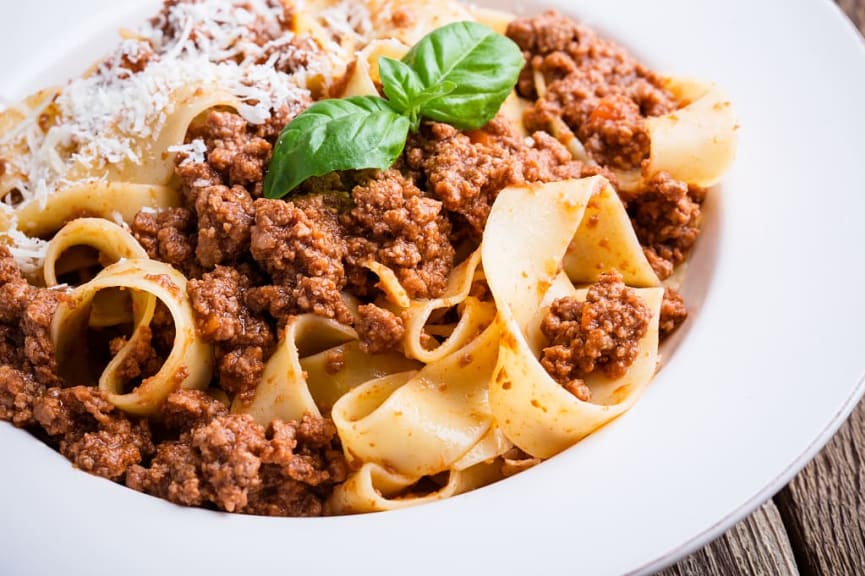5 Best Dishes to Try While on Vacation In Bologna

Rural farmhouse in Bologna, Emilia-Romagna, Italy
Bologna’s famous delicacies derive from a rich culinary tradition that has impacted the cuisine of greater Italy, and there are several dishes you should try on your vacation. Historians have documented the culinary brilliance of the city since the Middle Ages, with published texts capturing the fascinating creations of inventive chefs dating back to the 16th century. The tradition of long-lasting products derived from a nomadic heritage in the mountains. Nowadays, food lovers from around the world visit Bologna to sample firsthand the unique dishes and robust flavors you can experience on your Italy tour.
1. Bolognese Sauce

Pasta with Bolognese Sauce
Bologna is known for the meaty and hearty Bolognese sauce, known locally as ragú. The dish originated in France from sauces using meat broth but leaving out the actual meat with the pasta. By the 18th century, documents show the first meat-based sauce served over pasta in Imola, a town near Bologna. Traditional ragú alla Bolognese uses sweating, sautéing, and braising techniques with meats like beef, pork, or veal, wine, tomato, and broth. The flavors combine over the course of hours as the sauce simmers with a bit of milk resulting in authentic aromas, a delicate flavor, and a creamy texture.
2. Parmigiano Reggiano PDO

Parmigiano Reggiano PDO
Parmigiano Reggiano is a famous cheese made with only milk, salt, and rennet. It’s generally aged up to 36 months and represents the king of Italian cheeses due to its nutritious qualities and an illustrious history dating back to 12th-century Benedictine monks. The flavors depend solely on the aging period making the cheese great when paired with vegetables, fruits, honey, meats, seafood, nuts, and balsamic vinegar. When visiting Italy, you can find the rich, salty flavor as a snack or as part of a larger meal.
3. Prosciutto di Parma

Prosciutto di Parma
While technically from the nearby city of Parma, the two have long been connected by close proximity and a love of food. Prosciutto is the cured hind legs of pork made by rubbing and massaging an amount of salt over the outside of the meat proportionate to the weight of the meat itself. The particular microclimate of the Emilia-Romagna region helps flavor the curing pork by carrying the aroma of olive trees, pine groves, and chestnuts. The ham atypically ages for up to 12 months, which gives you a sense of flavor shaped by surrounding elements in every bite.
4. Tortellini in Brodo

Tortellini in Brodo
Tortellini in Brodo is a typical dish whose spirit is captured in the essential recipes of Bologna. The dish consists of stuffed pasta cooked in a hearty broth and dates back to the mid 16th century, once favored by the ruling classes. While typically enjoyed around Christmas, the traditional dish can give you layers of bountiful flavor found in the filling of pork, mortadella, and prosciutto, as well as the broth often made from chicken stock. Part of the tradition of eating tortellini is gathering the family around to make the dumplings, a custom you can also take part in on a customizable Italy food tour.
5. Lasagna

Lasagna
While history states lasagna started in Naples, it has become a staple of traditional Bolognese cuisine famous for its classic twist on familiar flavors. During your tour of Italy, you can explore the distinctive recipe of Bolognese lasagna by uncovering the layers of ragù, noodles, cheese, and bèchamel sauce. The city also claims fatherhood as the birth of lasagna because of innovative chefs who started using alternative ingredients like spinach and grated Parmigiano.
How to Plan your Vacation to Bologna

Bologna, Italy
Bologna food is committed to local ingredients and tradition weaving the array of flavors from the heritage to daily contemporary life. The food culture reflects the uniqueness of the region’s soil and its link to renewing the farm-to-table movement. On our Italy Tours page, you can find inspiration for a personalized Italy food tour or learn more about how to experience your best trip with Zicasso’s Italy Travel Guide. Planning a trip? Speak with an Italy travel specialist by filling out a Trip Request or by calling our team at 1-888-265-9707.
Life-Enriching Travel Designed Just for You
- 1
Trips curated by the world’s top destination experts
- 2
Concierge-level service leading up to and during your trip
- 3
Unique, exclusive experiences and insider access





